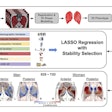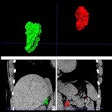Sunday, December 1 | 11:05 a.m.-11:15 a.m. | SSA20-03 | Room E351
Does a hot or cold cathode source in your mini C-arm offer the best x-ray image quality?South Korean researchers compared x-ray images acquired with carbon nanotube-based cold cathode and tungsten-based hot cathode ceramic tubes in a portable mini C-arm fluoroscopy system, and they will discuss their findings in this Sunday presentation.
In their preclinical study, the researchers used a specially designed device that contained sealed ceramic-type cold cathode and hot cathode x-ray tubes and a flat-panel detector. From there, they internally developed a carbon nanotube emitter and x-ray tubes designed to function at high anode voltage without arcing.
The carbon nanotube-based cold cathode x-ray source emitted 20% less radiation while producing the same image quality with the same exposure time as the hot cathode x-ray source. In addition, the response to digital pulses was three times faster with the carbon nanotube-based cold cathode x-ray source. The cold cathode source also had a 40% smaller focal spot size.
Using a carbon nanotube-based cold cathode source in a mini C-arm fluoroscopy system provides improved function, higher-quality x-ray images, and reduced radiation dose, compared with a hot cathode x-ray source, the researchers concluded.











